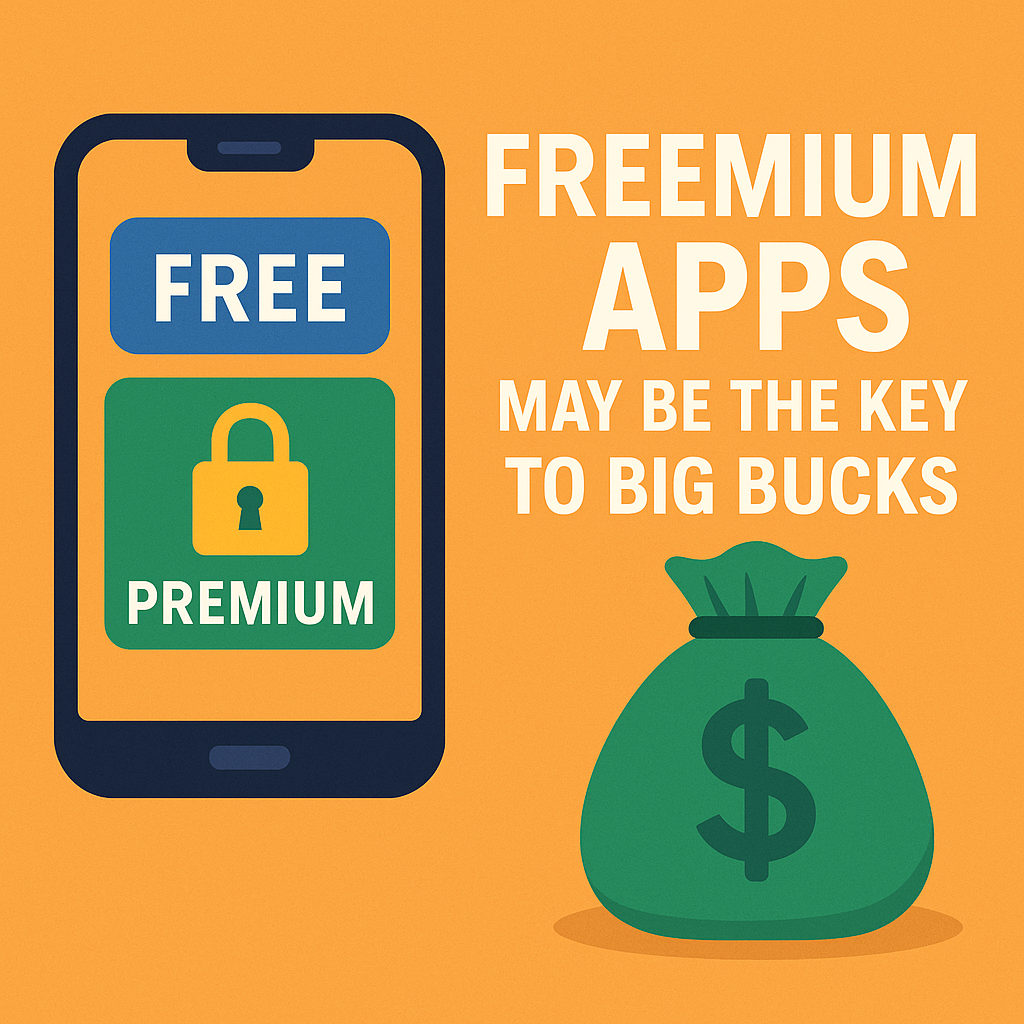Freemium Apps May be the Key to Big Bucks
I’ve spent years analyzing app monetization, and one model consistently stands out: freemium apps can generate serious revenue when executed well. In 2025, with mobile app revenues expected to reach $613 billion, freemium apps like Spotify, Canva, and Duolingo are proving their worth by attracting millions of users with free access and converting a small percentage into paying customers who fuel massive profits. So, what makes freemium apps such a smart bet, and how can developers maximize their potential without frustrating users? Let’s break it down.
Why Freemium Apps Matter
Early on, I questioned the idea of offering an app for free. Why give away something you worked hard to build? Then I looked at the data. A 2024 Statista report shows that 97% of Google Play Store apps and 95% of Apple App Store apps are either free or freemium, dominating the market. The logic is simple: free access draws in a huge audience. Even if only 2–3% of users upgrade to a paid version, that small group can generate millions when the user base is large enough.
Spotify is a prime example. In 2020, it earned $7.88 billion, with 45% of its users paying for premium subscriptions, according to Spotify’s financial overview. The free, ad-supported version hooks users with unlimited music streaming. Once they’re invested, features like ad-free listening and offline playback encourage them to upgrade. It’s a long-term strategy focused on loyalty, and it pays off.
How Freemium Apps Generate Revenue
Freemium apps don’t just rely on goodwill; they use smart monetization tactics. Here’s how I’ve seen developers turn free users into profit:
- In-App Purchases: These are huge in gaming apps like Candy Crush or Clash of Clans, where players buy virtual goods like coins or boosts. Clash of Clans pulls in roughly $1.5 million daily from in-app purchases, as reported in Sensor Tower’s analysis of top mobile games.
- Subscriptions: Apps like YouTube and Spotify offer premium tiers with benefits like no ads or exclusive content. In 2021, subscriptions drove $13.5 billion in revenue for the top 100 non-game apps on the App Store, per App Annie’s report on mobile trends.
- Ads: Free versions often feature banner ads, interstitials, or rewarded videos. Mobile ad spending reached $277 billion in 2020, and it remains a key revenue stream, though it requires careful balance to avoid annoying users.
- Referral Programs: Referral-based apps like Airbnb create viral loops, which reduce user acquisition costs significantly.
This approach keeps marketing costs low while expanding the user base. - Data Monetization: Some apps collect anonymized user data for market research, but transparency is critical to comply with regulations like GDPR. Ethical opt-in models are becoming more common in 2025.
Here’s a quick breakdown of these approaches:
| Strategy | Best For | Pros | Cons |
|---|---|---|---|
| In-App Purchases | Gaming, creative apps | High revenue potential | Relies on engaged users |
| Subscriptions | Media, productivity apps | Recurring revenue | Needs compelling premium perks |
| Ads | Social, entertainment apps | Easy to implement | Can annoy users if overdone |
| Referrals | Social, marketplace apps | Low-cost user acquisition | Requires strong user base |
| Data Monetization | Analytics-driven apps | Passive income | Privacy concerns |
The Psychology of Freemium Success
Freemium apps work because they tap into how people behave. I’m drawn to free tools myself—it’s why I’ll try a new app if there’s no upfront cost. The freemium model capitalizes on this by offering enough value to keep users engaged. Once they’re invested, whether it’s hours spent building a Clash of Clans base or organizing projects in Evernote, they’re more likely to pay for premium features.
The secret is the “value ladder.” Start with a free version that solves a real problem, like Canva’s basic design tools. Then, offer premium features that feel essential, such as Canva Pro’s advanced templates. A London Business School study found that launching a free version can increase demand for the paid version by 8.9%, as users experience the app’s value firsthand.
Real-World Freemium Success Stories
Here are a few apps that have mastered the freemium model:
- Spotify: Free users get ad-supported streaming, while premium subscribers enjoy offline playback and better audio quality. With over 100 million premium subscribers, Spotify’s approach is a benchmark for balancing free and paid tiers.
- Canva: Free design tools attract millions, but Canva Pro’s extra features have converted over 5 million users, contributing to a $40 billion valuation, as noted in Forbes’ coverage of Canva’s growth.
- Duolingo: Free language lessons with ads keep users engaged, while premium subscriptions eliminate ads and add offline access. Duolingo’s model has made it a top educational app, per App Store rankings.
- Evernote: Free note-taking with limited storage draws users in, while premium plans offer more space and offline access. It’s a textbook case of upselling based on user needs.
These examples show that freemium is about delivering value first, making the paid upgrade an easy decision.
Challenges to Avoid
Freemium isn’t foolproof. I’ve seen developers struggle when they misjudge the balance. Here are some pitfalls I steer clear of:
- Overly Limited Free Versions: If the free version feels useless, users won’t stick around. A design app that blocks saving files, for example, is a dealbreaker.
- Excessive Ads: Too many ads can push users away, especially when developers focus more on monetization than user experience.
I test ad placement to ensure it doesn’t disrupt the experience. - Low Conversion Rates: Typically, only 0.5–2% of freemium users pay, so a large user base is essential. This requires early investment in user acquisition.
- High Costs: Supporting millions of free users gets expensive fast, which is why freemium success requires sustainable economics.
Everpix, a photo storage app, failed because it couldn’t convert enough users to cover costs, as detailed in TechCrunch’s analysis of Everpix’s collapse.
To navigate these, I lean on data. Tools like MyTracker help me identify where users drop off or what features drive upgrades. User feedback from surveys and reviews also reveals what’s working and what needs tweaking.
How to Succeed with Freemium in 2025
Based on my experience and research, here’s my approach to building a freemium app that delivers results:
- Deliver Real Value for Free: The free version should address a core need. Duolingo’s free lessons are genuinely useful, encouraging daily use.
- Make Premium Compelling: Highlight premium benefits without devaluing the free experience. Spotify’s ad-free option is a strong incentive but doesn’t diminish the free tier.
- Use Smart Paywalls: Time-based paywalls (e.g., a 7-day trial) or feature-based paywalls (e.g., extra storage) work well. Make upgrades easy with one-tap purchases.
- Track User Behavior: Track user behavior with analytics to optimize your app, just as you would when improving demo-to-paid conversion rates. If users abandon the app at a specific point, adjust that feature or flow.
- Experiment Constantly: Split-test free vs. premium features to find the right balance. A/B testing helped PlantSnap increase downloads after adopting freemium, per a Business of Apps case study on freemium strategies.
- Prioritize Retention: Engaged users are more likely to pay. Gamification and personalization strategies can work wonders—just look at how mobile studios revive engagement through innovation.
Why Freemium Is a Smart Long-Term Strategy
In 2025, the app market is fiercely competitive, but freemium apps have a clear advantage. They attract users who might never try a paid app, building a loyal base that drives organic growth through word-of-mouth. By focusing on value, balancing free and paid features, and using data to optimize, developers can turn freemium apps into a reliable revenue stream. It’s not about quick wins—it’s about creating an app users love and are happy to pay for over time.
Want to try freemium for your app? Start by offering a free version that solves a real problem, then test what premium features your users can’t resist. You might be surprised at the results.


